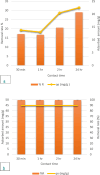Dynamic removal of methylene blue and methyl orange from water using biochar derived from kitchen waste
- PMID: 40813879
- PMCID: PMC12354772
- DOI: 10.1038/s41598-025-14133-6
Dynamic removal of methylene blue and methyl orange from water using biochar derived from kitchen waste
Abstract
Access to pure and clean water is an upcoming challenge globally due to increased pollution by household waste and industrial effluents, specifically artificial dyes, which are not biodegradable and pose toxicity. Low-cost, mass-producible, and efficient technologies, particularly in developing environments, are highly needed. In this study, Kitchen waste derived biochar was prepared from orange peels (OP), potato peels (PP), banana peels (BP), and coffee residue (CR) via pyrolysis in a muffle furnace at 400 °C for 1 h. The prepared biochar was characterized by BET surface area analysis and Fourier Transform Infrared spectroscopy (FTIR). Low-cost kitchen waste derived biochar (KWDB)-sand composite filter material was developed as an eco-friendly adsorbent for the removal of a cationic Methylene Blue (MB) and an anionic dye Methyl Orange (MO) from aqueous solutions . Systematic research on contact time (0.5 to 24 h) and initial dye concentration (5-25 mg/L for MO and 10-180 mg/L for MB) was conducted. KWDB had extremely high and constant removal efficiency of a maximum of 99.5% for MB, while removal of MO was contact time dependent and had the following highest removal of 29% after 24 h. Higher initial dye concentration resulted in greater adsorption capacities. Langmuir isotherm analysis gave maximum adsorption capacities of 25.15 mg/g for MO and 30.40 mg/g for MB, which are greater than for most of the other biochars. Isotherm modeling further revealed that MO adsorption would be according to a multilayer, heterogeneous mode and MB adsorption according to a monolayer mode. This biochar-based filter is an efficient and scalable treatment system for water, particularly in situations with limited infrastructure, in which locally produced filters can be quickly implemented as part of inexpensive decentralized treatment systems. These findings confirm the design of biochar-enhanced filtration modules tailored for specific dye pollutants and environmental settings.
Keywords: Adsorption; Biochar; Column; Dye; Kitchen wastes.
© 2025. The Author(s).
Conflict of interest statement
Declarations. Competing interests: The authors declare no competing interests.
Figures





Similar articles
-
Production and characterization of magnetic Biochar derived from pyrolysis of waste areca nut husk for removal of methylene blue dye from wastewater.Sci Rep. 2025 Jul 2;15(1):23209. doi: 10.1038/s41598-025-03359-z. Sci Rep. 2025. PMID: 40603323 Free PMC article.
-
Graphene Aerogel Derived from Luffa Sponge Biochar for Efficient Dye Removal from Wastewater.Langmuir. 2025 Jul 15;41(27):18028-18044. doi: 10.1021/acs.langmuir.5c01943. Epub 2025 Jul 4. Langmuir. 2025. PMID: 40614177
-
Cost-effective zinc ferrite-functionalized hydroxyethyl cellulose/chitosan film for efficient removal of methyl orange dye from aqueous solutions.Int J Biol Macromol. 2025 May;307(Pt 3):142232. doi: 10.1016/j.ijbiomac.2025.142232. Epub 2025 Mar 17. Int J Biol Macromol. 2025. PMID: 40107539
-
The Black Book of Psychotropic Dosing and Monitoring.Psychopharmacol Bull. 2024 Jul 8;54(3):8-59. Psychopharmacol Bull. 2024. PMID: 38993656 Free PMC article. Review.
-
Assessment of compost as a dual-performance bioadsorbent for removing heavy metals and textile dyes: an overview.Environ Monit Assess. 2025 Jul 3;197(8):854. doi: 10.1007/s10661-025-14285-y. Environ Monit Assess. 2025. PMID: 40610836 Review.
References
-
- Negri, C. et al. Anaerobic digestion of food waste for bio-energy production in China and Southeast Asia: A review. Renew. Sustain. Energy Rev.133, 110138 (2020).
-
- Slorach, P. C., Jeswani, H. K., Cuéllar-Franca, R. & Azapagic, A. Environmental sustainability in the food-energy-water-health nexus: A new methodology and an application to food waste in a circular economy. Waste Manage113, 359–368 (2020). - PubMed
-
- Chavan, S., Yadav, B., Tyagi, R. D., Wong, J. W. C. & Drogui, P. Trends and challenges in the valorization of kitchen waste to polyhydroxyalkanoates. Biores. Technol.369, 128323. 10.1016/j.biortech.2023.128323 (2023). - PubMed
-
- El-Saadony, M. T. et al. Hazardous waste and management strategies of landfill leachates: A comprehensive review. Environ. Technol. Innov.31, 103150. 10.1016/j.eti.2023.103150 (2023).
MeSH terms
Substances
LinkOut - more resources
Full Text Sources
Miscellaneous

